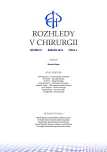Laparoskopické ošetrenie perforácie čriev po tupom brušnom poranení (BAT) u detí
Authors:
P. Zahradnikova 1; J. Babala 1; Ľ. Sýkora 1; J. Trnka 1; M. Vidiscak 2; P. Sinka 1; L. Fědorová 1
Authors‘ workplace:
Paediatric surgery department and Faculty of medicine, Comenius University in Bratislava, National institute of children’s diseases, Bratislava
1; Department of surgery, Faculty of medicine, Slovak Medical University in Bratislava
2
Published in:
Rozhl. Chir., 2018, roč. 97, č. 3, s. 139-144.
Category:
Case Report
Overview
Pri liečbe chirurgických diagnóz v detskom veku sa stala miniinvazívna chirurgia štandardnou liečbou. V literatúre je len málo štúdií, ktoré by popisovali využitie laparoskopie pri tupej traume brucha u detí. V článku predkladáme naše skúsenosti s laparoskopiou pri tupej traume brucha u detí. Popisujeme dve kazuistiky pacientov s perforáciou čreva po tupej traume brucha riešenej laparoskopicky. U oboch pacientov bola perforácia čreva identifikovaná laparoskopicky, oboch sme aj laparoskopicky vyriešili. Prvého pacienta sme ošetrili laparoskopicky pokračujúcou sutúrou perforácie čreva, druhého pacienta sme riešili laparoskopicky asistovane. Obaja pacienti sa zhojili bez ťažkostí. Miniinvazívna chirurgia pri suspektnej perforácii hornej časti gastrointestinálneho traktu je možnou metódou voľby. Domnievame sa, že laparoskopia môže poskytnúť dôležité informácie pre diagnostiku a liečbu poranení vnútrobrušných orgánov. U detí môže spresniť diagnostiku a v indikovaných prípadoch môže znížiť množstvo komplikácií laparotomickej explorácie dutiny brušnej. Miniinvazívna chirurgia pri tupej traume brucha je možná u hemodynamicky stabilného pacienta.V rukách skúseného ,,laparoskopického“ chirurga môže znížiť pooperačnú bolesť pacienta, zlepšiť následný kozmetický efekt, skrátiť dobu hospitalizácie, ako aj umožniť skorší návrat dieťaťa do školských a športových aktivít. Nemožno opomenúť, že u hemodynamicky nestabilného pacienta ostáva ,,zlatým“ štandardom exploratívna laparotómia.
Kľúčové slová:
miniinvazína chirurgia − tupá trauma brucha – laparoskopia − perforácia čreva
Sources
1. Nastanski F, Cohen A, Lush SP, et al. The role of oral contrast administration immediately prior to computed tomographic evaluation of the blunt trauma victim. Injury 2001;32:545−9.
2. Sherk JP, Oakes DD. Intestinal injuries missed by computed tomography. J Trauma 1990; 30:1−5.
3. Ross S, Dragon G, O’Malley K, et al. Morbidity of negative celiotomy in trauma. Injury 1995;26:393−4.
4. Shih C, Wen S, Ko J, et al. Noninvasive evaluation of blunt abdominal trauma: prospective study using diagnostic algorithms to minimize nontherapeutic laparotomy. World J Surg 1999;23:265−70.
5. Carrillo H, Spain D, Wohltmann C, et al. Interventional techniques are useful adjuncts in nonoperative management of hepatic injuries. JTrauma 1999;46:619−24.
6. Carnevale N, Baron N, Delany H, et al. Peritoneoscopy as an aid in the diagnosis of abdominal trauma: a preliminary report. J Trauma 1977;7:634−41.
7. Feliz A, Shultz B, McKenna C, et al. Diagnostic and therapeutic laparoscopy in pediatric abdominal trauma. J Pediatr Surg 2006;41:72−7.
8. Marwan A, Harmon C, Georgeson K, et al. Use of laparoscopy in the management of paediatric abdominal trauma. J Trauma 2010;3:215−8.
9. Streck C, Lobe T, Pietsch J, et al. Laparoscopic repair of traumatic bowel injury in children. J Pediatr Surg 2006;41:1864−9.
10. Carbon R, Baar S, Waldschmidt J, et al. Innovative minimally invasive paediatric surgery is of therapeutic value for splenic injury. J Paediatr Surg 2002;37:1146−50.
11. Madsen H. Ultrasound contrasts: the most important innovation in ultrasound in recent decades. Acta Radiol 2016;49:247−8.
12. Miele V, Piccolo C, Trinci M, et al. Diagnostic imaging of blunt abdominal trauma in pediatric patients. Radiol med 2016;121:409−30.
13. Bège T, Brunet C, Berdah S, et al. Hollow viscus injury due to blunt trauma: A review. Journal of Visceral Surgery. 2016; 153:61−8.
14. Alsayali D, Atkin C, Winnett J, et al. Management of blunt bowel and mesenteric injuries: experience at the Alfred hospital. Eur J Trauma Emerg Surg 2009;35:482−8.
15. Hughes T, Elton C, et al. Intra-abdominal gastrointestinal tract injuries following blunt trauma: the experience of an Australian trauma centre. Injury 2002;33:617−26.
16. Lien G, Mori M, Enjoji M, et al. Delayed posttraumatic ischemic stricture of the small intestine. A clinicopathologic study of four cases. ActaPatholJpn 1987;37:1367−9.
17. Ekeh A, Saxe J, Walusimbi M, et al. Diagnosis of blunt intestinal and mesenteric injury in the era of multidetector CT technology—are results better? J Trauma 2008;65:354−9.
18. Ross S, Dragon G, O’Malley, et al. Morbidity of negative celiotomy in trauma. Injury 1995;26:393−4.
19. Fabian TC, Croce MA, Stewart RM, et al. A prospective analysis of diagnostic laparoscopy in trauma. Ann Surg 1993;217:557−64.
20. Ball CG, Karmali S, Rajani RR, et al. Laparoscopy in trauma: an evolution in progress. Injury 2009;40:7–10.
21. O’Malley E, Boyle E, O’Callaghan A, et al. Role of laparoscopy in penetrating abdominal trauma: A systematic review. World J Surg 2013;7:113–22.
22. Villavicencio RT, Aucar JA, et al. Analysis of laparoscopy in trauma. J Am Coll Surg 1999;189:11–20.
23. Marwan A, Harmon C, Georgeson K, et al. Use of laparoscopy in the management of pediatric abdominal trauma. J Trauma 2010; 69:761−94.
24. Alemayehu H, Clifton M, Santore M, et al. Minimally invasive surgery for pediatric trauma - a multicenter review. Journal of laparoendoscopic&advanced surgical techniques. 2015; 25:243−7.
Labels
Surgery Orthopaedics Trauma surgeryArticle was published in
Perspectives in Surgery

2018 Issue 3
Most read in this issue
- Suprakondylická zlomenina humeru u dětí
- Hirschsprungova choroba v dospělém věku − dvě kazuistiky a přehled literatury
- Otevřená versus laparoskopická operace akutní apendicitidy u dětí
- Laparoskopie na pracovišti dětské chirurgie v pětiletém období
